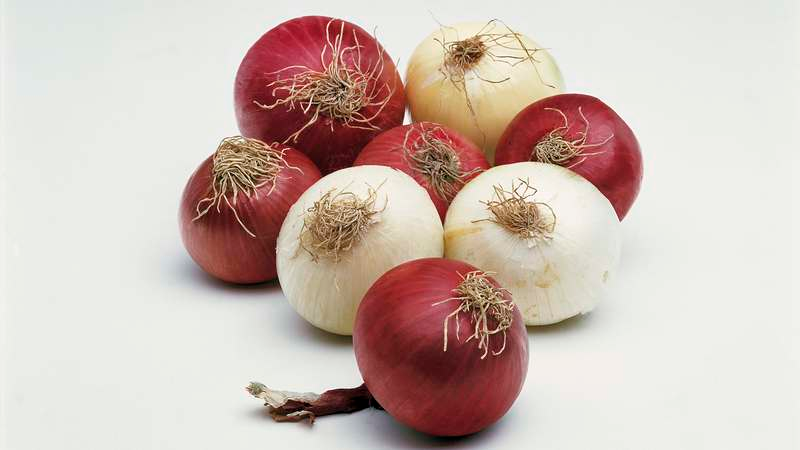How To Minimize Crying When Chopping Onions
We think of onions as harmless root vegetables, but they're actually clever bulbed bombs ready to defend themselves against all would-be consumers. They quietly lie waiting in farmer's fields and grocery bins, but spring to action when a hungry critter bares its teeth or the chef's blade comes down. The attack is a familiar one. After the first cut, an onion transforms itself into a terrorizing weapon of tear production. But why do onions make us cry? And how can we protect ourselves from this onslaught of tears?
First, some botany. Onions are a part of the genus allium, which includes leeks, shallots, garlic, chives, and scallions. These vegetables develop their characteristic oniony taste and pungent burn from sulfur extracted from the soil as they grow. In particular, the depth and variety of alliums' flavors stem from a class of chemicals known as amino acid sulfoxides, and agricultural scientists have determined that restricting access to sulfur as the plant grows can drastically alter the resulting flavor. The Vidalia onion, for example, grows in the low-sulfur soil of Georgia, resulting in measurably fewer sulfoxides and a sweeter, milder taste (without an actual increase in the sugar content).
This potent onion flavor, however, makes the plants attractive to wild animals looking for a snack. Alliums, therefore, need a defense mechanism that wards off hungry herbivores and makes themselves less enticing as lunch. In addition to the sulfoxides, these vegetables separately produce a number of enzymes that break down the sulfur compounds into irritating agents. In garlic, the enzymes produce allicin, a molecule that stings and burns on direct contact, while certain varieties of chive produce a mild cabbage smell. Onions have the most famous defense of all: Their enzymes produce sulfenic acid that rapidly breaks down into thianosulfinate, the chemical responsible for pungent onion odor, and syn-propanethial-S-oxide, a volatile gas that stimulates our eyes to make tears.
This chemical compound with a mouthful of a name is the reason onions make you cry, but it's only half the story. The real genius of alliums like the onion is that the two ingredients needed to turn on the water works—the sulfoxides and the enzymes—are produced independently and stored separately within the plant; only when an animal bites or a cook chops do the cell walls rupture, bringing the ingredients together. Once the chemical reaction starts, the onion produces the irritant as fast as it can, and the gas begins to bubble out. As the fumes rise and accumulate near your face, your eyes go on the defensive—Make tears! Flush the invaders!—and the build-up of onion vapor reaches peak-pain after about 30 seconds. The reaction is short-lived: Within five minutes, all the available enzymes are used up, and production stops. While the lingering cloud can still do damage, the vegetable salvo is over.

The simplest strategy to protect yourself from an onion attack is to minimize the tearful cloud you produce from the start. Using a freshly sharpened knife and cutting quickly and cleanly means less bruising and breakage—and ultimately less weeping. This is the "trick" employed by professional chefs who don't have time to fuss around, but at best it will limit, rather than eliminate, how much syn-propanethial-S-oxide is produced.
Similarly, small gains can be made if you put limits on how the chemical reaction proceeds. Peeling and soaking your onion in water for several minutes before cutting can flush away some of the sulfur compounds, leaving less raw material to be turned into irritant. This flushing, however, also unfortunately drains away a lot of onion flavor as well. Chilling your onions ahead of time is another option. When the temperature is lowered, the resulting gas produced will be less volatile, and so will be less likely to spread wildly. Fridge temperatures aren't generally low enough (the onion quickly warms back up as you cut it), but frozen onions make fewer tears (though are harder to cut and slipperier to handle.)
Since the breakdown of the sulfur compounds seems hard to stop (and yields a tastier vegetable anyway), maybe we're going about this the wrong way. Can we let the onion vent and just limit our exposure? Wearing goggles is a straightforward, yet fashionably questionable method as it protects your eyeballs until the worst of the gas has past. But if you manage to touch your face or eyes when you remove the goggles, the allicin on your fingertips (that's the skin-burning by-product most potent in garlic, but present in onions, too) may still tickle your tear ducts indirectly. More practical solutions are to cut onions by an oven exhaust or window fan to draw the chemical haze away, or to do your slicing in the sink under running water to flush the annoying enzymes away before they make harm. This last option, though, presents some serious logistical challenges. Wet knife? Wet onions? Lost food bits down the drain, and an increased likelihood that you'll cut yourself? The (potential) reduction in tears hardly seems worth it.
Really, the best method is just to engineer tear-free onions from the start. It happens that the eye-watering syn-propanethial-S-oxide is the product not just of a single onion enzyme, but of a complicated dance between three different enzymes in the onion. If any one of these is cut out of the process, the result is the production only of thianosulfinate—the strong odor and important flavor compound—and none of the eye irritant. Agricultural gurus in New Zealand have used gene suppression to do just this, and claim to have made a tear-free allium (that retains all its tasty onion zest). Though not yet commercially available, this onion's technology might signal the true end to onion's reign of teary terror.
So is there one foolproof protection against a good cry? Not yet. But maybe weeping after vanquishing a worthy opponent isn't such a bad thing after all. Those salty tears can season your dish, too.
